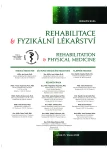Occupational Intervention with Tobii PCEye Plus Eye Navigation for Clients with Pervasive Developmental Disorder
Authors:
A. Gebauerová; A. Kuželková; M. Pešák; Y. Angerová
Authors‘ workplace:
Klinika rehabilitačního lékařství 1. LF UK a VFN v Praze, zastupující přednosta kliniky MUDr. Y. Angerová, Ph. D., MBA
Published in:
Rehabil. fyz. Lék., 27, 2020, No. 1, pp. 51-56.
Category:
Original Papers
Overview
Eye tracking navigation Tobii PCEye Plus is an assistive technology which scans, evaluates and records user´s sight focused on a monitor. It is primarily used as a compensatory device by clients with communication disabilities. It fully replaces a keyboard and a mouse because it captures eye movements fast and very accurately. It helps to improve social interactions and it can control all pc functions and home appliances, and so it increases maximum self-sufficiency. There are special programs designed for the Tobii. The most used program for clients with pervasive developmental disorder is called Look to learn thanks to which clients can easily train how to use the device. Capabilities of the Tobii technology are significantly enhanced by DiagView extension, which generates a graphical representation of a client’s eye movement analysis after a proven activity. It records in colors the intensity of points and maps where were directed the client’s eyes during the activity. This allows the device to be used for diagnosis and intervention. The intervention in these cases focuses on improvement of communication, social interactions and games. This device comes from Sweden, where it is used by occupational therapists, special teachers and speech therapists. The article aims to acquaint the reader with the possibilities of occupational intervention with Tobii PCEye Plus eye navigation. Six case studies were conducted with clients with pervasive developmental disorder.
Keywords:
occupational therapy – eye tracking Tobii PCeye Plus – pervasive developmental disorder – self-help devices – assistive technology – alternative communication
Sources
1. BAXTER, S., ENDERBY, P., EVANS, P., JUDGE, S.: Barriers and facilitators to the use of high-technology augmentative and alternative communication devices: a systematic review and qualitative synthesis. International Journal of Language & Communication Disorders [online]. 2012, 47(2), 115-129 [cit. 2019-06-22]. DOI: 10.1111/j.1460-6984.2011.00090.x. ISSN 13682822. Dostupné z: http://doi.wiley.com/10.1111/j.1460-6984.2011.00090.x.
2. ČEVELA, R., ZVONÍKOVÁ, A.: Děti s pervazivní vývojovou poruchou. In: Ministerstvo práce a sociálních věcí [online]. Praha, 2012, 15. 11. 2012 [cit. 2019-06-04]. Dostupné z: https://www.mpsv.cz/cs/13898.
3. GANZ, J. B., Kristi, L., MORIN, M., FOSTER, J. et al.: High-technology augmentative and alternative communication for individuals with intellectual and developmental disabilities and complex communication needs: a meta-analysis. Augmentative and Alternative Communication [online]. 2017, 33(4), 224-238 [cit. 2018-30-05]. DOI: 10.1080/07434618.2017.1373855. ISSN 0743-4618. Dostupné z: https://www.tandfonline.com/doi/full/10.1080/07434618.2017.1373855.
4. HALEY, S. M. et al.: Pediatric evaluation of disability inventory (PEDI): Development, Standardization and Administration Manual. Version 1.0. Boston: Boston University, 1992. 300 s.
5. KRIVOŠÍKOVÁ, M.: Úvod do ergoterapie. Praha, Grada, 2011. ISBN 9788024726991.
6. MACLELLAN, L. E.: Evaluating Camera Mouse as a computer access system for augmentative and alternative communication in cerebral palsy: a case study [online]. Boston, 2018 [cit. 2018-08-31]. Dostupné z: https://open.bu.edu/bitstream/handle/2144/27568/MacLellan_bu_0017N_13534.pdf?sequence=7&isAllowed=y. Dissertations. Boston university. Vedoucí práce Cara E. Stepp, Ph.D.
7. Mezinárodní klasifikace nemocí: 10. revize: duševní poruchy a poruchy chování: popisy klinických příznaků a diagnostická vodítka. 2. vyd. Praha, Psychiatrické centrum, 2000. ISBN 80-85121-44-1.
8. MURIAS, M., MAJOR, S., DAVLANTIS, K., FRANZ, L., HARRIS, A., RARDIN, B., SABATOS-DEVITO, M., DAWSON G.: Validation of eye-tracking measures of social attention as a potential biomarker for autism clinical trials. Autism Research [online]. 2018, 11(1), 166-174 [cit. 2019-06-22]. DOI: 10.1002/aur.1894. ISSN 19393792. Dostupné z: http://doi.wiley.com/10.1002/aur.1894.
9. OŠLEJŠKOVÁ, H.: Poruchy autistického spektra: poruchy vyvíjejícího se mozku. Pediatrie pro praxi. Olomouc, Solen, 2008(9), 80 - 84. DOI: 1803-5264. ISSN 1803-5264.
10. RICKHEIT, G., STROHNER, H.: Handbook of communication competence. New York: Mouton de Gruyter, 2008. ISBN 978-3-11-018829-5.
11. SENSORY SOFTWARE INTERNATIONÁL. Look to learn: Aktivity pro cílený pohled, Manuál. Praha, 2011. Dostupné také z: https://www.alternativnikomunikace.cz/soubor--111-.pdf.
12. SPEKTRA VDN. Spektra.eu. Tobii PCEye Plus.[online]. Praha, Spektra v.d.n., 2017 [cit. 2019-06-22]. Dostupné z: https://spektra.eu/tobii-pceye-plus/
13. ŠAROUNOVÁ, J.: Metody alternativní a augmentativní komunikace. Praha, Portál, 2014. ISBN 978-80-262-0716-0.
14. VESSOYAN, K., STECKLE, G., EASTON, B. et al.: Using eye-tracking technology for communication in Rett syndrome: perceptions of impact. Augmentative and Alternative Communication [online]. 2018, 1-12 [cit. 2018-31-08]. DOI: 10.1080/07434618.2018.1462848. ISSN 0743-4618.
15. WARREYN, P., VAN DER PAELT, S., ROEYERS, H.: Social-communicative abilities as treatment goals for preschool children with autism spectrum disorder: the importance of imitation, joint attention, and play. Developmental Medicine & Child Neurology[online]. 2014, 56(8), 712-716 [cit. 2019-06-09]. DOI: 10.1111/dmcn.12455. ISSN 00121622. Dostupné z: http://doi.wiley.com/10.1111/dmcn.12455.
16. WHITEFORD, H. A., FERRARI, A. J., DEGENHARDT, L., FEIGIN, V., VOS, T., FORLONI, G.: .The global burden of mental, neurological and substance use disorders: an analysis from the global burden of disease study 2010. PLOS ONE [online]. 2015, 10(2) [cit. 2019-05-04]. DOI: 10.1371/journal.pone.0116820. ISSN 1932-6203. Dostupné z: http://dx.plos.org/10.1371/journal.pone.0116820.
Labels
Physiotherapist, university degree Rehabilitation Sports medicineArticle was published in
Rehabilitation & Physical Medicine

2020 Issue 1
- Hope Awakens with Early Diagnosis of Parkinson's Disease Based on Skin Odor
- Deep stimulation of the globus pallidus improved clinical symptoms in a patient with refractory parkinsonism and genetic mutation
Most read in this issue
- Impedance Therapy in Rehabilitation of Degenerative Disease of the Spine
- Influence of Lymphatic Drainage on the Fracture of Ankle Joint Solved by Osteosynthesis
- Effect of Prosthesis on Body Posture and Postural Stability in Upper Limb Amputees
- The Use of Cognitive Dual Tasks in Evaluating the Level of Postural Control
